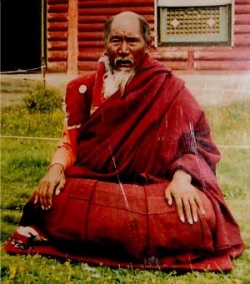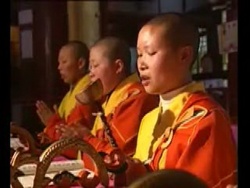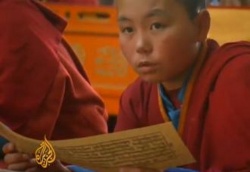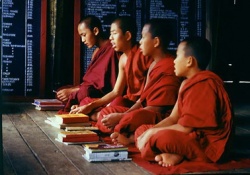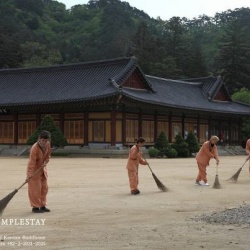Manual of Vinaya - CLASS NOTES part 2
Class Six: The Ten Non-Virtues and their Karmic Results
The Ten Non-Virtues:
The Ten Non-Virtues, or paths of karma, comes from the Great Book on the Steps of the Path (LAM RIM CHEN MO), by Je Tsongkapa. The Chapter on the True, and the Sutra on the Ten Levels, describe the results, or “consistent consequences,” associated with each of the 10 Non-Virtues. These consequences are explained in this class.
Avoiding the ten Non-Virtues is the basis of all ethical living. Leading an ethical life can bring you to nirvana. If there’s something in your life that you don’t like, you can figure out the karmic cause and remove it by cleaning up your thoughts and behavior. You focus on removing the causes (unethical conduct) that create future consequences. We constantly do all ten non-virtues. The understanding of the relationship between the ten non-virtues and the resulting quality of your life should run your life, based on a rational analysis of your current sufferings, what caused them, and how to stop them in the future.
To get the full bad karma from these ten misdeeds, you must be doing them intentionally, to the point of completion, with clear understanding of the error, and with harmful thoughts in your mind (the strength of the result depends on all four factors being present). In the U.S., we generally refrain from misdeeds either because of an external authority like God, parents, social norms, or the law; or because of the embarrassment of doing it in public. These are irrelevant myths or bases of ethical conduct. Our proper motivation should be to stop planting bad seeds in our mind so that we can reach nirvana.
Je Tsongkapa states, “Great Lamas of the past have expressed the position that the ‘Consistent Consequence‘ is where, even if you do manage to take birth as a human, you enjoy killing things, etc.; and that experiencing the various results listed below is a ‘Ripened Consequence.’” Finally, “Environmental Consequences” relate to the land and the surroundings in which you live.
The following presentation defines the misdeed, and for each misdeed lists the “consistent result” (the personal consequence you experience because you have done that specific misdeed), and the “environmental result” (the characteristics you perceive in your environment because you have done the misdeed).
Results of Doing the Ten Non-virtues:
1. Killing any living being. It includes abortion, suicide (ruining a body that could have reached nirvana in this life), and participating in the military (even being a cook; it’s as if you shot the gun yourself).
Personal Result: Your life is short; and you get sick easily, have little energy.
Environmental Result: Food, drink, medicine, crops, have very little effect, are always inferior, are not nutricious; are hard to digest, cause disease in you. Most beings around you die before reaching the end of a full life.
2. Stealing anything of value; includes shady business deals, cheating on rent, taxes, or bills, underpaying what’s due to local government or society, etc.
Personal Result: You don’t have enough to live on or to make ends meet; and what you do have is all just common property with others.
Environmental Result: The crops are few and far between, they have no power to remove hunger, they spoil or never come up; dry spells stay on too long; it rains too much; the crops dry up or die off.
3. Sexual Misconduct. It mainly means adultery—cheating on your partner, a person to whom you are exclusively committed. It also includes some specific secondary behaviors.
Personal Result: The people who work around you are “inconsistent” (unreliable); and you find yourself having a lot of competition for your partner.
Environmental Result: You live in a place where there is urine and feces all around, and mud, dirt, filth; everything stinks, and everywhere seems unpleasant and distasteful.
4. Lying, giving someone else a wrong impression about what you’ve seen, believe, or know; unless it would save someone’s life or prevent real suffering. If you lie and get something, the benefit comes from past good deeds, not from the lie.
Personal Result: No one believes what you say, even when you’re speaking the truth; others are always deceiving you.
Environmental Result: Your work in cooperation with others fails to prosper and people around you don’t work well together; everyone generally is cheating one another and is afraid, and there are many things to be afraid of.
5. Divisive Talk, splitting people up with your talk; saying things to alienate or separate two different people, (regardless of whether or not your words are true); causing one person to like another person less; it’s usually subtle, like in your tone of voice.
Personal Result: You lose friends easily; people around you are always fighting one another; and people around you have an undesirable character.
Environmental Result: The ground you live in is split up, uneven, covered with crags and gullies, highs and lows, so travel is difficult and you are always afraid and there are many things to be afraid of.
6. Harsh Talk, with bad intent and effect; it includes sarcastic “nice” words and swearing.
Personal Result: You hear many unpleasant things, you hear things as bad sounds; and when others talk to you it always seems to you as if they want to start a fight.
Environmental Result: The ground where you live is covered with obstacles like fallen tree trunks, thorns, stones, sharp broken glass; it’s rough, dreary, no streams or water springs; the ground is parched and poisoned, burning hot and threatening; there are many things to fear.
7. Idle Talk, meaningless chatter; criticism, disputes, useless joking, whining, complaining, speaking out of the motive of attachment or craving; gossiping about politics, sports, etc., or about people engaged in wrong livelihood; reciting prayers while not thinking about their meaning. Gossiping about other’s values or spiritual practice. Dharma is sacred and should be discussed in holy private whispers on special nights, not causally — talk in hushed tones, very beautiful sacred speech, talk about inspiring things. As an aspiring bodhisattva, you may need to discuss mundane topics with others for their benefit, but keep the ultimate goal in mind, and don’t be drawn into worldly conversations.
Personal Result: No one listens to you; no one respects what you say—no one thinks that what you say has any particular value; and you are afflicted with a lack of confidence, and self-esteem.
Environmental Result: Fruits refuse to grow, or grow at the wrong times, seem ripe when they’re not, have frail roots; there are no leisure places around like parks, or pools of cool water; many things around make you afraid.
8. Craving/Coveting is similar to coveting in the ten Commandments. Wanting others’ possessions and personal qualities, like their intelligence, health, fame, youth, spiritual achievements. It comes in five stages: you’re attached to your own possessions, desire to accumulate more than you have, discover another’s possessions, like to make them your own, and the desire becomes unmanageable and you “lose shame” (then you act).
Personal Result: Your personality is dominated by desire; and you are never satisfied with what you have.
Environmental Result: Every good thing you manage to find starts to get worse, decrease as days, months, and seasons pass.
9. Ill-Will is to wish bad things upon others; being pleased when others fail or have misfortune; competitiveness, like, “Oh, how did they mess up? Tell me more…” not feeling as bad for an unfortunate person as you would feel for yourself if you were them.
Personal Result: Your personality is dominated by anger; you are always finding yourself without help, or never find the help you need; and you are always hurting others, or always being hurt by others.
Environmental Result: You live in a world of chaos, diseases spread, evil is everywhere, plague, conflict, fear of harm from the military, dangerous animals, you’re surrounded by harmful spirits, thieves or muggers, etc.
10. Wrong View, “Incorrect world view” means not regarding karma as being the direct cause of every microsecond of experience we have. This leads to doing misdeeds #1-9.
Personal Result: Your personality is dominated by stupidity; you are a person who keeps harmful views; and you are a deceitful person.
Environmental Result: You live in a world where the single highest source of happiness is steadily disappearing from the earth; where people think that unclean and suffering things are actually nice and happy; where there is no place to go, no one to help you, nothing to protect you.
Four Types of Karmic Results: Committing the ten misdeeds leads to these four types of karmic results:
1. NAM MIN A ripening result, (as in the ripening of fruit or a blister). It means “to be ready, inclined to experience the result,” and refers to the realm in which your rebirth will occur:
a. Big bad deeds lead to birth in the hell realm.
b. Medium bad deeds lead to birth in the craving spirit (preta) realm.
c. Small bad deeds lead to birth in the animal realm
2. GYU TUN A result consistent with the cause, consistent with the karmic cause cause consistent you have personally created. The great scriptures list two consistent causes for each misdeed. For example, if you killed other beings, your own life will be short, and/or you will get sick easily. Based on your knowledge of these cause and effect relationships, you can determine the specific causes and design a future that is free of these sufferings.
3. Consistent Consistent karmic result. Je Tsongkapa says that great Lamas of our lineage have described another kind of consistent cause, which is the tendency to do the same misdeed over and over again in the future, to be attracted to doing the misdeed. It means attraction toward ingrained habits.
4. Environmental Result Environmental results relate to how you experience the physical earth and society in which you live—the world around you.
The karma of committing not to do these ten misdeeds is an exercise of renunciation, not just something cool to do. There is no way to fundamentally change the external world around you; rather, you should have intelligent self-interest and eliminate bad karma in order to change what you don’t like about your own experience. The vows are the way to remove your unhappiness. You will notice how your life changes, and it’s great fun, makes your life charmed, magical, special, beautiful. Forget about shamata, vipashyana and other tricks for the time being; you must be purified first.
Class Seven: Taking and Keeping the Vows
The Kind of Person Who Can Grow the Individual Freedom Vows:
TEN Something upon which something else rests, or is based upon. In vinaya,
Foundation foundation refers to an appropriate body and mind with which to take the individual freedom vows. Those who possess any of the following seven characteristics are ineligible to take the vows:
1. Beings who live on the Northern Continent of Unpleasant Sounds. These beings always live a secure 500-year life, and therefore can’t have renunciation (we live on the Southern Continent).
2. Those who are impotent and unable to engage in sexual relations; the male/female energy gives you strength to practice.
3. Neutered persons, who lack sexual energies.
4. Hermaphrodites, who lack pure sexual energies.
5. Anyone who has committed one of the five immediate bad deeds (killing your father, mother, or an arhat; trying to hurt a Buddha; and causing a schism in the sangha during the time that Lord Buddha walked on this earth.)
6. Imposters, who pretend to take the vows, from curiosity, or any other insincere reason.
7. People who doesn’t believe in karma, rebirth, or the Three Jewels.
How You Lose the Individual Freedom Vows:
TONGWAY GYU How you can lose the vows.
lose vows what makes you
A. General causes of losing all the individual freemon vows:
1. LAPPA PUL Formally give back, return the vows; the vows are taken for life precepts to offer for reasons of renunciation.
2. SHI PU To die and move on. You automatically lose all individual freedom vows at death.
3. TSEN NYI JUNG If the opposite sex organ emerges.
4. LEN SUM GYUR If you change gender three times or more. times three change
5. GE TSA CHE If you destroy the root of your accumulated virtue. virtue root of cut
B. Specific causes of losing specific individual freedom vows:
1. NYI SHU MALUN DERSHE You lose your full monk vows if it’s discovered that 20 years old didn’t reach found out you weren’t twenty years old when the vows were taken, and you are still not twenty.
2. TEN CHIR KE LANG You lose your intermediate nun’s vows if you agree have sex agree to do to have sex with a man.
3. NYIN SHAK DE The one-day vow ends after 24 hours. 24 hour passes
2 additional ways to lose vows, according to Sutrists and the Under-the-Sun School:
1. TSA TUNG JUNGWA If you commit one of the defeats you instantly lose your defeat if you break vows.
2. DAMCHU NUPPA If the holy Dharma disappears in the land. Buddha Dharma if it declines However, the Tibetan “Kashmiri-Detailist” school, which we follow, believes:
BULUN NORNDEN SHIN Having the vows is like being a very rich man, and have a debt be rich metaphor breaking the vows is like owing a debt which is huge but smaller than the riches; the vows can be irreparably damaged, but not lost, by committing one of the defeats.
The Benefits of Taking and Keeping the Individual Freedom Vows:
1. NEKAP DREBU HLA MI You avoid rebirth in the three lower realms. short-term result deva human
2. TARTUK DREBU JANGCHUB SUM You will reach the three enlightenments ultimate result enlightenments three (Listeners, Self-made Buddhas, Mahayana.)
JE TSONGKAPA His name comes from the TSONG river which runs through the Tibetan province of Do Kam.
The Meaning of the Name, “Essence of the Ocean of Disipline”:
Essence: The individual freedom vows are the most extraordinary, essential core of vinaya; more precious than a wish-fulfilling jewel.
Ocean: Understanding in detail the principles of vinaya, and its great structure, is similar to the ocean’s great depth and richness, from whence comes precious jewels.
Discipline: You tame (dulwa) your sense organs and mental afflictions.
Class Eight: Introduction to the Steps of the Path
LAM RIM Staps of the Path. The last three classes will cover the Lam Rim which was path steps taught by Lord Buddha in the Perfection of Wisdom Sutras, and later revived by Master Atisha. Lam Rim study grounds you in the essence of all Buddhist teachings. It’s a presentation of all the steps you need to get to Buddhahood.
LAM RIM DUDUN Short Book on the Steps of the Path, by Je Tsongkapa (1357-1419.) path steps brief He wrote several versions of the LamRim, including his masterpiece presentation the LAM RIM CHEN MO. The brief and very personal version of the Lam Rim is also called:
JEY NYAM GUR Song of My Spiritual Life
of the personal song
lord experience
The Lineage:
The continuation of the Buddhist lineage is extremely important as the means of passing down the authentic essence of the teachings from heart to heart, mind to mind, through the ages. You have to be a receptacle, and the Lama has to pour water into you, and then you keep that water purely and pour it into the next person that you teach.
1. SHAKYA TUPPA Shakyamuni Buddha, “capable one of the Shakya clan,” Gautama Buddha (500 B.C.). Buddha knows the words to help every being reach nirvana and paradise, and has the power to emanate in order to teach us.
SHING TAY SOLJE The inventor of the horse-drawn carriage, a simple but wooden horse inventor elegant device of ancient India, is used as a metaphor for the two great commentators of Buddha’s sutras: Maitreya/Asanga and Manjushri/Nagarjuna.
2a. JETSUN JAMPA Maitreya. He mainly taught love, “widespread behavior,” spending your whole life thinking about and helping others. Caring only for others automatically makes you happy.
2b. JAMPAY YANG Manjushri, Gentle Voice. He mainly taught wisdom, “the vision of emptiness.”
3a. Asanga (350 a.d.) Taught mainly bodhisattva behavior, as dictated by Maitreya; Asanga transmitted the teachings to Atisha through Serlingpa. The Lineage (cont.)
3b. Nagarjuna (200 a.d.) Taught mainly the view of emptiness, dictated by Manjushri; he transmitted the teachings to Atisha through Vidyakokila.
4. Atisha (982-1052) Wrote the Lamp on the Path, the first Lam Rim book. It systematically combines the lineages of the teachings on bodhisattva activity and wisdom.
5. Subsequent Lamas From Atisha up the present day, and following. Prophecies in the sutras say that Buddhism will continue for another 2,500 years by Western people; we are a conduit to pass along the teaching to others perfectly, purely, clearly.
NYINPO DORDU SELWA Illumination of the Essence, by Choney Lama Drakpa Shedrup essence brief illumination (1675-1748). It emphasizes the importance of the unbroken lineage of bodhissatva behavior and wisdom. This lineage is a fragile thing which can only be transferred from teacher to student , and not through books alone.
If you study only a brief summary of the Lam Rim, you have basically covered all 3,500 works of the Kangyur and Tengyur.
Four Special Qualities of the Lam Rim Teaching:
1. Realize all the teachings are free of any inconsistency. You realize that some incredible genius has set up this huge system that all fits together perfectly. Although the different Buddhist schools present disparate views from one another based on the capacity of their students, all the schools are a perfectly interlocking puzzle designed to help people reach enlightenment.
2. Every teaching strikes you as personal advice. Your personal contemplations and meditations will relate to each and every sentence of all the Buddha’s teachings if you’re connecting with your Lama and purely practicing the Lam Rim.
3. Easily grasp the intent of the Buddhas (of their teachings). You will come to understand why the Buddha taught every specific point, and why they are all a necessary part of the Lam Rim.
4. Save you from the great abyss. You will avoid the great mistake of outrightly rejecting one of the teachings. This doesn’t mean you should blindly accept a point which you don’t believe right now, but rather that you should set aside the point for later consideration instead of permanently rejecting it.
Class Nine: Description of the Lower Scope
Finding and Relating to Your Teacher:
SHE NYEN Your Lama; your blood relative, your friend.
DE NE DI CHIY LEKTSOK JINYEPAY
and then this & later all the good how ever many
TENDREL LEKPAR DRIKPAY TSAWA NI LAM TUN SHE NYEN
get off to get it right exactly right pivotal path who blood friend
a good start moment shows you relation
Your Lama is your blood brother, your close friend. Your relationship with your Lama is the great pivot of your escape from samsara. Your most important job is to find your Lama. If you mess up one tiny bit of the chemistry it’s destructive; if the vibe is just right, this life and all of your future lives will be excellent. Finding a Lama with the following ten qualities is very important, but you must also trust your heart. You give your whole life to your Lama (and you get it all back). Your Lama doesn’t want anything from you except for your own happiness, for you to learn and practice well. Your offering to your Lama is your Buddhist practice.
10 Characteristics of a Qualified Teacher:
1. DULWA Controlled, keeping the three sets of vows (pratimoksha, discipline bodhisattva, and secret). If they are not living an ethical way of life, they will only hurt you or waste your time.
2. SHIWA Peaceful; they have have the ability to concentrate deeply. peace
3. NYER SHIWA Have wisdom; they have a broad and deep understanding of really peaceful emptiness.
4. YUNTEN HLAKPA Far exceeds the students’ spiritual qualities (in having compassion, spiritual excessive wisdom, etc.)
qualities
5. TSUN CHE Dedicate their life to the two goals: ultimate enlightenment for effort has themselves and for others’benefit. All their energy is focused upon saving themselves and others from continued suffering.
6. LUNG GI CHUK Mastery of the scriptures: of the vinaya, sutra, and abhidharma scripture in wealth collections of scripture.
7. DE-NYI RABTOK They have perceived emptiness directly, and can explain the true emptiness great realization relationship between moraltiy, karma, and emptiness.
8. MA KE DEN A master teacher: they can grasp the students’capacity, and teach teach master possess at the appropriate intensity and speed to benefit the students.
9. TSEWAY DAKNYI Have the right motivation: they have love and compassion for the love embodiment of students’ultimate benefit; not money, respect, fame, etc.
10. KYOWA PANG They never get impatient with students, are infinitely forgiving; distaste gave they never tire of giving repeated explanations or difficult teaching. it up
Connecting with Your Teacher:
This is critical: Your Lama is your only connection to the Buddhas. Being in their presence wears out enormous karma, so you must think of them and treat them as special in order to continue their appearance to you. The emotion you feel toward them generates great new karma; to venerate, bow down to them is very holy. Take advantage of the holy moment. When your virtue is good enough, you’ll find your Lama. They are empty and your karma is creating them. Your perception of them as a holy teacher is based on your karma, and their perception of themselves as a holy teacher comes from their karma. The highest good deed is to find your root Lama and give yourself to Him or Her. This is the first and most important path; don’t have ignorant attachment to them, but give your heart to them with wisdom.
Taking refuge means trusting in the relationship between karma and emptiness. Refuge comes from two things::
1. You are afraid of something.
2. You think that something can help you. We take refuge in the Three Jewels:
1. Buddha Jewel: symbolically, a statue of Buddha. The real Buddha Jewel is the dharmakaya, the emptiness of a Buddha, which you meet on the Path of Seeing when you perceive emptiness directly.
2. Dharma Jewel: symbolically, the books, and scriptures. The real Dharma jewel is:
a. Cessations: For example, of having to be reborn in the lower realms, or of believing intellectually in the self-existence of things.
b. Paths: For example, the five Paths, or the three Principal Paths.
3. Sangha Jewel: symbolically, ordained monks and nuns. The real Sangha jewel is all those who have perceived emptiness directly.
The Four Powers:
The Four Powers, or Four Fources, can be used to wipe out your bad karma, if used with strength, on a daily basis. They are explained in Je Tsongkapa’s Song of My Spiritual Life:
1. TEN GYI TOB Refuge and bodhichitta. Start with the basics. basis of force
2. NAMBAR SUN JINPAY TOB Regret. The intelligent regret of an educated totally wipe out force Buddhist; the logical knowledge that you’ve just planted a seed that will cause you suffering in the future.
3. NYEPA LE LARN DOKPAY TOB Restraint. Not doing the bad deed again in the bad deed karma restrain yourself force future based on your intelligent regret. Choose an in the future appropriate and manageable time frame, like one hour, or one month during which you will be able to avoid the misdeed.
4. NYENPO KUNTU CHUPAY TOB Antidote. An action to make up for the bad karma. antidote some activity force For example, memorizing scripture, or doing a loving act that offsets the bad deed. The ultimate antidote is to study and meditate on emptiness, which naturally will lead you to avoiding bad deeds.
The Diamond-Cutter Sutra states that if you do these Four Powers well, a bad karma that otherwise would take you to the lowest hells could ripen as a mere headache.
Class Ten: Description of the Medium and Greater Scopes
PAKBA DENPA SHI The Four Arya Truths:
1. DUK NGEL DEN-PA The Truth of Suffering. It includes:
a. Impure vessel of the world, the suffering world we live in.
b. Impure contents, the suffering bodies and minds of living beings.
2. KUN JUNG DEN-PA The Truth of the Cause of Suffering. It includes:
everything truth
a. Karma, our impure actions of body, speech and mind.
came from
b. NYON MONG PA Mentally afflicted things. Anything that is truth number one, suffering, is also truth number two, the cause of suffering. It includes nearly everything around you, everything in your life except your meditation and pure practice during the day. Everything else in our lives is suffering.
3. GOK DEN The Truth of the End of Suffering. It includes:
a. GAKJA which is stopped by the path, for example, eliminating the intellectual belief in self-existent things, based on seeing emptiness directly.
b. GAKJA “stopped” by Middle-Path reasoning, proving the non-existence of something that never could have existed in the first place, which is emptiness.
4. LAM DEN The Truth of the Path. The cause of the end of suffering.
a. The Paths of Accumulation and Preparation.
b. The Paths of Seeing, Habituation, and No More Learning.
The Six Perfections:
a. Giving material things; food, money, pleasant enjoyable things, etc.
b. Giving freedom from fear; protecting beings from physical danger, anxiety, etc.
c. Giving Dharma; teaching people how to escape from suffering.
2. Perfection of Morality. It includes vinaya, bodhisattva and tantric morality.
3. Perfection of Not Getting Angry; patience. Restraining yourself from anger in any situation.
4. Perfection of Joyful Effort. Have a good time doing virtue, love it, have fun doing good.
5. Perfection of Concentration.
SHI NEY Meditative concentration, (skt., shamata) is the ultimate form of peace to stay concentration. It is defined as: “Meditative concentration which is infused with the extraordinary pleasure of agility, brought on by being in deep one-pointed concentration upon the particular object of focus.”
HLAK TONG Vision of emptiness, (skt., Vipashyana), the direct perception of special, seeing, emptiness. It’s defined as: “A state of wisdom which is infused with extraordinary vision the extraordinary pleasure of agility brought on by analyzing its particular object of focus, all based on a platform of quietude.” You are analyzing the self-existence of an object of focus, and realizing that it doesn’t really exist, but is a projection of your mind forced on you by your past karma.
The last two perfections in tandem are extremely powerful, and they must come together in order to perceive emptiness directly. To do so, it is absolutely necessary to meditate one or two hours every day in order to reach a state of concentration where your focus on a holy object is not distracted by sense impressions or any conceptual thought. You need to arrange your life to accommodate good meditation time for this purpose. And you must first deeply study the Madhyamika view of emptiness in order to understand what you’re looking for.
See also
- Manual of Vinaya - Reading One: Je Tsongkapa’s Epistle on Ethics
- Manual of Vinaya - Reading Two: Outline of the Sutra on Discipline (Vinaya Sutra)
- Manual of Vinaya - Reading Three: Introduction to the Vows of Individual Freedom
- Manual of Vinaya - Reading Four: A General Description of the Vows, Part One
- Manual of Vinaya - Reading Five: A General Description of the Vows, Part Two
- Manual of Vinaya - Reading Six: Taking and Keeping the Vows
- Manual of Vinaya - Reading Seven: The Ten Non-Virtues, and their Karmic Results
- Manual of Vinaya - Reading Eight: Introduction to the Steps of the Path
- Manual of Vinaya - Reading Nine: Description of the Lesser Capacity
- Manual of Vinaya - Reading Ten: Description of the Medium and Greater Capacities
- Manual of Vinaya - CLASS NOTES part 1
- Manual of Vinaya - CLASS NOTES part 2
